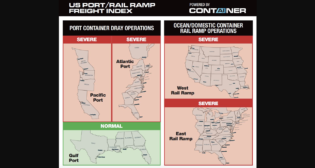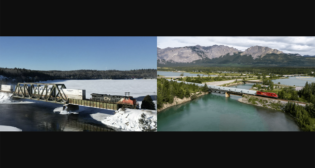
STB and Reciprocal Switching: Abject Regulatory Failure
Written by James Nolan, Ph.D., University of SaskatchewanFrank Wilner and Bill Huneke have started a friendly debate in this publication over the merits and demerits of the recent STB ruling on reciprocal switching. As an academic who has done research on this topic, I hope to join in the discourse whereby this missive represents my humble contribution. It was difficult to limit my perspective on this issue, but I have chosen to give some background on the equivalent set of regulations in Canada as motivation.
As readers know, up in Canada in the railroad sector we have a long-standing regulation known as interswitching. Like reciprocal switching, interswitching is a form of regulated access, whereby a sole-served shipper can request that a competing railroad be permitted to operate on the host railroad to pick up traffic. In Canada, the implementation of this regulation is not governed by operational concerns, but rather by location. Today, so long as the switching point to a competing railway is within a 30 km (18 mile) radius of the shipper, interswitching is granted and subject to a set of regulated rates, based on car numbers and distance.
While an interesting spatial issue, prior research of mine looked at taking that radius and simulating what would happen if interswitching regulations were extended to longer distances. That research was limited to a single but important shipper group—grain shippers—in a limited region—Western Canada—to keep the analysis tractable. It turns out that Canada’s grain elevator and rail network topography is such that not all grain shippers could access these new regulations, even at switching distances beyond 200 km (120 miles). Using prior research on rate setting in different sized rail markets, we found that grain shippers using the regulation would see some sharing of rents, but this never amounted to more than a small percentage of the total revenue Canadian railroads receive annually on grain movement.
In part due to this research, and with at the time serious grain delivery issues in Western Canada, in 2014 the Federal government decided to expand interswitching distance to 160 km, but applicable only to the Western Canadian region. The industry players were told that this was going to be a three-year trial, with the outcomes assessed and the regulation re-evaluated. While the outcomes were never readily made available, what data I have seen from shipping groups shows a few things:
- It took shippers some time to get to understand the new regulation and try to implement it. By year 3, more shippers were using actual interswitches more than in year 1, but the number of actual interswitches only averaged about 5-6 per month on multiple thousands of regional rail movements.
- Looking at rail industry fluidity numbers over this time, it seems this number of physical interswitches did not noticeably affect railroad performance.
- Personal contacts have told me that the new regulations, and mostly just the threat of an interswitch, were so successful at allowing shippers to negotiate rates with their host railroad that once the trial period ended, the Canadian railroads lobbied very hard with government to reset basic interswitching to the original distance metrics. They were successful in the latter, but further changes are now being contemplated to support shippers.
So imagine my interest when I heard that the STB was considering new reciprocal switching regulations, and in addition were well aware of the Canadian experience, both in theory and practice. Prior to the 2023 notice, I had spoken at length to both Deb Miller and Patrick Fuchs at various conferences about the merits of Canadian interswitching. I even testified at the 2022 STB hearings about the situation in Canada and what I found with what data I could access. Subsequently both Canadian railroads paid a couple of consultants—neither of whom I have ever heard of in my 25 years as an academic and journal editor—to try to refute my testimony in subsequent STB submissions. In any case, this was a real chance, I thought, not only to harmonize these particular regulations across the border but also to create a real competitive rail transportation threat for U.S. shippers and allow them to negotiate (if possible) better rates and service. Again, the regulation’s real power comes not from the actual switched movements (with minimal effects on rail operations), but from that (contestable) threat level.
During my career, I have followed the STB’s actions as much as possible. Most recently, it was very unusual to see the latest Chair frequently berate, for lack of a better word, the railroads for all sorts of operational infractions, service, rates, congestion, etc. Like many, due to this I believed this was the Board finally implementing a regulatory framework that was founded in contestability theory (like SAC) but would have some real clout in that railroads would be competing not with virtual railroads, but real ones.
So what did we get? A surprise for many of us in that the STB decided to focus reciprocal switching implementation on service factors only and left the issue of rates on the shelf. Without going into a critique of output or service regulation, let’s just say that one unintended consequence of the new regulations is that they could permit a railroad to better implement discriminatory pricing: Under the proposed regulations, if service to a shipper wanes, before the STB can get involved based on service metrics, the railroad could then conduct a price search over the shipper’s willingness to pay for better service, effectively being able to charge more and more to that shipper to simply maintain a given level of service.
My best guess is that like the old reciprocal switching, the new one will never be implemented in support of shippers. The reciprocal switching notice is simply a massive regulatory failure by an agency apparently unwilling to provide either the effort or public service for which it exists. Reciprocal switching in the U.S., if alternatively implemented as in Canada, would never ruin a railroad financially and simply allows a more equitable sharing of rents by shippers and carriers on a case-by-case basis.
A final note on my profession, the tactics of the AAR, and the notion of expertise. While I have not read through it completely, as the AAR submission on reciprocal switching is more than 600 pages, much of it consists of contributions/papers from academics who as far as I can tell have only rarely, if ever, published anything in a refereed journal about the rail industry. While there were a couple of individuals I had heard of professionally (in a different context) as well as a reliance on an association with Harvard University, please ask yourself how much these individuals were paid to take a particular research perspective about an industry they probably almost never think about.
I say this knowing there are plenty of very good railroad academics out there, but because rail is not a terribly “sexy” industry these days, most current rail academics are not affiliated with the Ivy League. No one I am familiar with doing relevant and active rail research was part of the AAR submission. However, I suppose if Ken Arrow (see the 1999 BN-CN merger proceedings), a Nobel Prize winning creator of competitive general equilibrium theory, can have a price (paid by BN presumably) to say he believed monopoly is a good outcome for society, I guess it is not surprising that the AAR once again found a few willing economics and business school professionals with just enough ethics to take their money to produce ostensibly “academic and objective” input about an industry and regulatory situation in which they have only rarely or never published. Shame on them.

James Nolan, Ph.D. ([email protected]) is a Professor in the Department of Agricultural and Resource Economics at the University of Saskatchewan in Canada. For almost 25 years, he has published research on a variety of transportation related topics, but his primary focus at present is on freight transportation issues. James is a past President of the Transportation Research Forum, is the editor of the Journal of the Transportation Research Forum (Elsevier) and serves as a topical editor (agricultural and food transportation) for the Transportation Research Record journal, published by the TRB. He is not from New York State, but from just across the border in southern Ontario (Belleville). James moved to Montreal as a child and as such is “a fallen Montreal Expos fan,” he says. “I never worked for the AAR, but Dad was a railroader, so I grew up with that dinner table discussion.”



